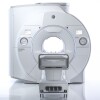Street reopens following MRI explosion danger
by Brendon Nafziger, DOTmed News Associate Editor | January 07, 2011
Families can now return to a street in a St. Louis County city after officials evacuated residents because of fears a tornado-damaged MRI would explode.
"It’s all been successfully mitigated, it’s over," fire chief Tim White told DOTmed News.
White said the Mehlville Fire Department blocked off about a half-mile of Lindbergh Boulevard in Sunset Hills Thursday night when technicians at the SSM Imaging Center informed him that there was a very small possibility an MRI unit would burst during decommissioning, as its ventilation system was damaged by a tornado that struck the facility on New Year's Eve. During the emergency, a local Holiday Inn Viking offered rooms to families forced to flee over the explosion risk.
"I had to make the decision last night, based on information I received," White said.
White said the department cordoned off a 330-foot radius surrounding the storm-wrecked imaging center as engineers with General Electric Co., the MRI's manufacturer, didn't know the extent of possible damage.
"They couldn’t tell us what the magnitude of the explosion from overpressurized [gas] would be," he said.
SSM Heath Care-St. Louis, which runs the site, said it had worked "around the clock" with GE to solve the problem. It estimated the risk of bursting during decommissioning was very slim, at less than 1 percent.
“We just decided to err on the side of caution,” Kristen Johnson, a spokeswoman for the group, told DOTmed News.
Larry Knight, president of Altima Diagnostic Imaging Solutions LLC., an MRI and CT service company, said the unit bursting would have been possible but unlikely.
"It would take a lot of bad events in a perfect sequence to get a magnet to a point where it would explode, or even blow off a turret cap," he said.
Winding down MRI units requires quenching them, or letting the highly pressurized liquid helium escape as a gas. With improper ventilation this has, on extremely rare occasions, caused part of the unit to burst. But changes in manufacturing in the mid-90s have made a magnet explosion much less likely on newer machines, Knight said.
Still, it does happen. In January 2007, a magnet at the University of Alabama at Birmingham blew up, demolishing the MRI suite. And a 2006 local news video showing part of an older MRI machine popping as it was being vented in a hospital lot became a YouTube sensation.
Wlad Sobol, a medical physicist with University of Alabama, estimates there have been about five MRI magnet explosions over the past decade, according to an article in Flesh and Stone.
As for the SSM Imaging Center, it was "pretty much destroyed" by the tornado that swept through town last week, Johnson said. However, the building had been closed since Nov. 3, as employees and equipment were being consolidated at the new SSM St. Clare Health Center in Fenton, Mo., a hospital which opened in March 2009.
"It’s all been successfully mitigated, it’s over," fire chief Tim White told DOTmed News.
White said the Mehlville Fire Department blocked off about a half-mile of Lindbergh Boulevard in Sunset Hills Thursday night when technicians at the SSM Imaging Center informed him that there was a very small possibility an MRI unit would burst during decommissioning, as its ventilation system was damaged by a tornado that struck the facility on New Year's Eve. During the emergency, a local Holiday Inn Viking offered rooms to families forced to flee over the explosion risk.
"I had to make the decision last night, based on information I received," White said.
White said the department cordoned off a 330-foot radius surrounding the storm-wrecked imaging center as engineers with General Electric Co., the MRI's manufacturer, didn't know the extent of possible damage.
"They couldn’t tell us what the magnitude of the explosion from overpressurized [gas] would be," he said.
SSM Heath Care-St. Louis, which runs the site, said it had worked "around the clock" with GE to solve the problem. It estimated the risk of bursting during decommissioning was very slim, at less than 1 percent.
“We just decided to err on the side of caution,” Kristen Johnson, a spokeswoman for the group, told DOTmed News.
Larry Knight, president of Altima Diagnostic Imaging Solutions LLC., an MRI and CT service company, said the unit bursting would have been possible but unlikely.
"It would take a lot of bad events in a perfect sequence to get a magnet to a point where it would explode, or even blow off a turret cap," he said.
Winding down MRI units requires quenching them, or letting the highly pressurized liquid helium escape as a gas. With improper ventilation this has, on extremely rare occasions, caused part of the unit to burst. But changes in manufacturing in the mid-90s have made a magnet explosion much less likely on newer machines, Knight said.
Still, it does happen. In January 2007, a magnet at the University of Alabama at Birmingham blew up, demolishing the MRI suite. And a 2006 local news video showing part of an older MRI machine popping as it was being vented in a hospital lot became a YouTube sensation.
Wlad Sobol, a medical physicist with University of Alabama, estimates there have been about five MRI magnet explosions over the past decade, according to an article in Flesh and Stone.
As for the SSM Imaging Center, it was "pretty much destroyed" by the tornado that swept through town last week, Johnson said. However, the building had been closed since Nov. 3, as employees and equipment were being consolidated at the new SSM St. Clare Health Center in Fenton, Mo., a hospital which opened in March 2009.
You Must Be Logged In To Post A CommentRegisterRegistration is Free and Easy. Enjoy the benefits of The World's Leading New & Used Medical Equipment Marketplace. Register Now! |
|









